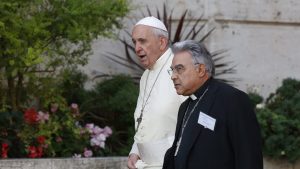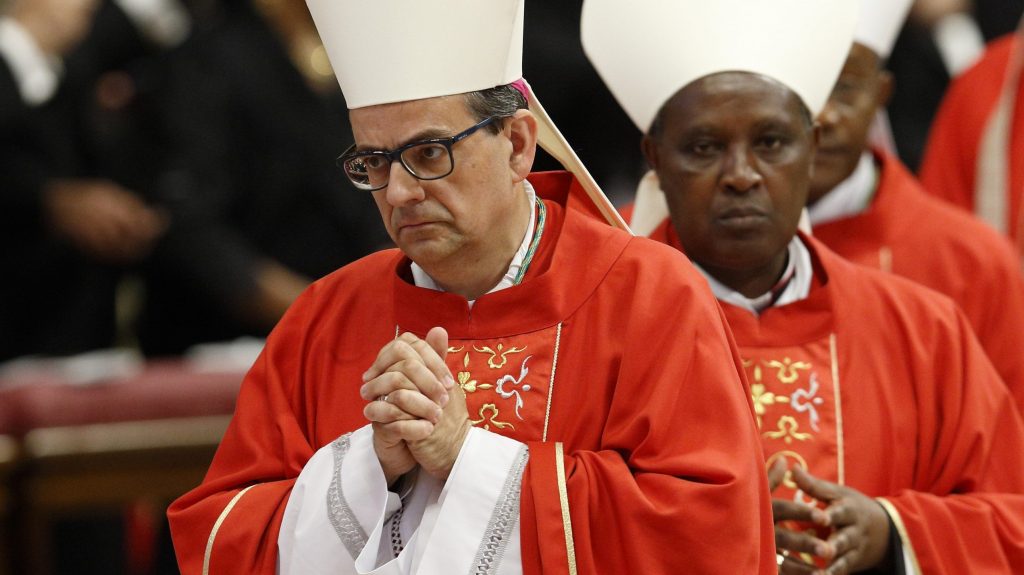ROME — Announced Sunday, Pope Francis’ new cardinal picks are a unique group and are illustrative of his longstanding vision for global Catholicism, containing several figures set to be key players in his reform efforts.
For weeks there have been rumors that Pope Francis would announce a consistory, and he confirmed those rumors Sunday, announcing during his weekly Angelus address that he would be handing out 13 new red hats in a consistory set for Nov. 28, the vigil for the Church’s liturgical season of Advent.
While on the one hand the consistory is potentially a surprise move given the current pandemic, on the other hand it was expected, as Pope Francis in recent weeks has named several allies to curial positions that almost automatically come with the red biretta attached, meaning a consistory was bound to happen sometime soon.
True to form, his picks also come from all over the world and further internationalize the College of Cardinals, which has been a goal since the beginning of Pope Francis’ papacy.
Following are the 13 cardinal-delegates, including nine under 80 and therefore eligible to vote in the next conclave, and four already past voting age:
- Maltese Bishop Martin Grech, the newly appointed secretary general of the Synod of Bishops
- Italian Bishop Marcello Semeraro, who was recently named prefect of the Vatican’s Congregation for the Causes of Saints
- American Archbishop Wilton Gregory of Washington, D.C.
- Archbishop Antoine Kambanda of Kigali, Rwanda
- Archbishop Jose Fuerte Advincula of Capiz in the Philippines
- Archbishop Celestino Aós Braco of Santiago, Chile
- Archbishop Cornelius Sim of Brunei
- Archbishop Augusto Paolo Lojudice of Siena and a former auxiliary bishop for the Diocese of Rome
- Father Mauro Gambetti, OFM Conv., who oversees the Sacred Convent in Assisi.
- Felipe Arzimendi Esquivel, bishop emeritus of the Diocese of San Cristobal de las Casas in Mexico (non-elector)
- Archbishop Silvano Maria Tomasi, the Vatican’s former observer to the United Nations in Geneva and a longtime ambassador (non-elector)
- Father Enrico Feroci, pastor of the Shrine of Holy Mary of Divine Love in Castel di Leva (non-elector)
- Father Raniero Cantalamessa, a Franciscan who for 40 years has served as the preacher for the Papal Household (non-elector)
From this list of appointees, three things are clear.
First, Pope Francis has further stacked the deck, meaning he has appointed individuals largely seen as sharing his agenda and who would take his line on important matters.
Bishop Semeraro had served as secretary for the pope’s Council of Cardinal advisers prior to his appointment as head of the Vatican’s department for saints, meaning he has followed Pope Francis’ reform up close and has had a hand in implementing the pope’s agenda from the beginning.

The fact that the pope chose Semeraro to take over for Italian Cardinal Angelo Becciu, who resigned last month at the pope’s request over allegations of embezzlement, shows just how much trust Pope Francis has in him.
Bishop Grech and Archbishop Gregory (who will be the United States’ first black cardinal) are also widely seen to be Pope Francis-men who would share his priorities and sympathize with his vision for the Church.
Appointing Archbishop Gregory at a time of intense racial tensions sends a clear message about the importance of the need to heal race relations, and heft that Archbishop Gregory can bring to the discussion.
And whether intentional or not, the fact that Archbishop Gregory’s appointment was announced during a contentious presidential election in which Archbishop Gregory has been vocally critical of President Donald Trump — issuing a fiery condemnation for disbanding peaceful protesters in order to visit an Episcopal church and the Saint John Paul II National Shrine in Washington, D.C. — could send the message that Pope Francis approves of Gregory’s actions, and has given his backing.
Archbishop Aós Braco is also a significant choice, as he is not only a “Francis man” himself, but he was placed in Santiago, Chile, on a mandate to clean up Chile’s massive clerical sexual abuse crisis, which resulted in all Chilean bishops offering their resignations, meaning Archbishop Aós Braco’s red hat is a sign of the pope’s confidence in his handling of the situation.
The “Franciscan” aspect of this crop is also of note, particularly the appointment of Father Gambetti, who was selected for the red hat over the presiding bishop in Assisi, Domenico Sorrentino, showing yet again how much this pope values the followers of his namesake, St. Francis of Assisi.

Second, it is clear with this group that Pope Francis is further seeking to diversify the College of Cardinals, selecting more prelates from Africa, Asia, and Latin America.
From the beginning of his pontificate, the pope has made a point of broadening the representation of the universal Church by handing red hats to bishops from obscure countries with small Catholic populations and which had never before had a cardinal.
This is also true for next month’s consistory, as Archbishop Kambanda’s appointment marks the first-ever cardinal for Rwanda, and Archbishop Sim the first red hat for Brunei.
Third, these appointments show that Pope Francis continues to bypass traditional cardinal-sees in favor of these smaller places.
For example, the pope this year is naming Archbishop Lojudice, the archbishop of Siena, as a cardinal, but there is still no red hat in Milan, a major archdiocese that always came packaged with a red hat, and where until now the absence of a cardinal was almost unthinkable.
Kigali, Capiz and Brunei all now have cardinals, yet other major and traditionally “red” archdioceses such as Venice, Los Angeles, and Philadelphia do not.
One key question at the moment is also how the consistory will happen, given that several of the appointees are in their 70s and 80s, meaning they are in the most at-risk category of the current pandemic, and might be hesitant to travel as Italy’s case numbers continue to rise.
Only time will tell if all 13 men show up to receive their red hats from the hands of the pope next month, or if some will choose to collect them at a later date.

